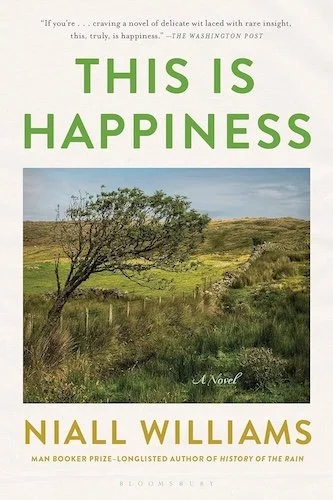This Is Happiness
With my first doctoral residency coming up in just about a month, I’m neck-deep these days in all the good stuff to read before then. A couple of essays on the art and craft of fiction. Two books I’ve read before and am eager to read again. A work of poetry. And two books totally new to me, by authors I’d never so much as heard of before.
One of those new-to-me books is This Is Happiness (Bloomsbury) by Niall Williams. It’s a novel set in the “small, forgotten village of Faha,” at a time—late 1950s, I think—when electricity was first making its way to otherwise forgotten villages in western Ireland. But light bulbs weren’t the only new development.
“It had stopped raining.”
That’s the entirety of chapter 1, followed immediately in chapter 2 by vivid descriptions of the many ways rain had manifested itself in Faha since, well, forever. “It came straight-down and sideways, frontwards, backwards and any other wards God could think of,” our narrator tells us. “It came dressed as drizzle, as mizzle, as mist, as showers, frequent and widespread, as a wet fog, as a damp day, a drop, a dripping, and an out-and-out downpour.” That is, until now.
When a novel begins with writing this good, you don’t need to have a clue where the story is going. You’re just happy to be along for the ride.
As soon as I finished the book—I adored every word of it, by the way—I went looking for interviews with the author. I wanted more of his ideas, more of his winsome Irish soul. In one fascinating conversation I found, Williams is asked how he thinks about plot, whether he’s a “meticulous plotter” or if he sometimes surprises even himself with where the story goes.
Williams answers the question by returning to that very first line of the book, the one about the rain having stopped:
“So I have no idea of the plot at all. None. . . . I have the sentence, the one sentence, and I can’t start until I get that sentence. . . . I have no idea what the book is about or where we're going or who the characters are, anything else. But I would describe the sentence as the tip of the thread that is poking out and my job every day is to tease that thread a little more each time. Not yank it and snap it, not force it. Just see, what would the next sentence be. What would the next one be. And little by little in the belief that when there is that tip of the thread in front of me, it is in fact an invisible coat. It’s fully there. It’s all there. And I just have to find out what it is. And so I pull the thread slowly, slowly, slowly until in the end over here, we have a real actual coat, which I believe was always the one that was implied by that first sentence.”
It reminds me a bit of Michelangelo’s signature conception of his craft: “The sculpture is already complete within the marble block, before I start my work. It is already there, I just have to chisel away the superfluous material.”
Personally, I’ve never seriously thought about writing a novel (or working with marble, for that matter). Short stories in the vein of Flannery O’Connor or George Saunders? Sure, the idea’s crossed my mind. But figuring out that perfect hidden structure for a full-length novel has always felt way too daunting. Unattainable. Don’t get me wrong, I admire those who do it well; I just don’t count myself among them.
Starting with one good sentence, though? That seems doable. To begin with a single sentence, a thread. Then slowly, patiently, gently, to pull at the thread and see where it takes us. Who knows, it might just be somewhere good.
